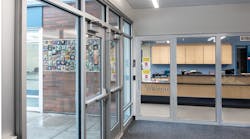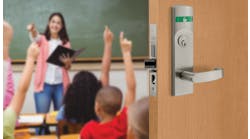For generations, schools and universities focused on access and convenience when selecting their doors and entry systems. Schools wanted students, parents and community members to feel comfortable in their facilities and traditionally chose all-glass, “storefront” doors to make their entrances bright and welcoming.
Today, after numerous high-profile school shooting incidents like Sandy Hook, Virginia Tech, and Columbine, campus violence has become a legitimate concern. And K-12 school districts and higher education institutions are rethinking how they choose doors and entry systems. “We’re seeing a shift in the balance from a focus on convenience to a focus on security,” says Doug Titus, a former school facilities manager who now serves as business development manager for Assa Abloy’s education division. “When I worked in schools and universities, security was always talked about as a priority, but often budgets did not reflect that. In the past 18 months, we have really seen schools make a shift to put greater emphasis on securing their facilities.”
That emphasis on security translates into how school facility managers select and maintain doors and entry systems. “School systems continually have to operate on fewer dollars per student, which has put a greater emphasis on selecting door and hardware products that will have longer lifecycles and the lowest maintenance,” says Charles “Sandy” Sanders, vice president of Wagstaff Taylor and Associates, a distributor and installer of access control systems, doors and frames. Sanders advises school facility managers to “spend the available dollars on function and longevity ahead of design and appearance.”
Here are several things to keep in mind when considering school and university entrances:
Door Decisions
• Consider replacing glass doors. Many schools that have the traditional glass doors are replacing those models to provide more privacy and security, Titus says. The newer designs include steel-stiffened doors and fiberglass reinforced polyester or fiberglass reinforced plastic doors, which are “very energy efficient and very secure,” Titus says.
• Strengthen glass doors. If replacing glass front doors is not an option right now, some schools are placing films and screens over their glass doors, which can delay entrance by an intruder. These screens and films make it more difficult for the glass to be broken as a way of gaining access.
• Consider storms. When replacing doors, keep in mind safety from storms as well as intruders. “Many states have now mandated that every new school have tornado safe rooms,” Sanders says. “The necessity of these safe rooms has dramatically increased the availability of FEMA 361 tornado door and shutters, along with the hardware necessary to withstand the wind loads associated with F-5 tornadoes.”
Considering Access
• Establish a visitor management program. In addition to installing safe doors and entry systems, schools must monitor who comes in and goes out with a visitor identification program, Titus says.
• Establish entrance and exit rules. Not only should doors be safe, but they also should be used correctly. Not every door should be available for public use. Each school or campus building should have a primary entrance, clearly marked with signage, to be used by all visitors, Titus says. Secondary entrances are those that students or faculty may access to go to the lunchroom or the playground, but should not be accessible by the general public. Finally, doors that are not needed for entrance on a daily basis should be marked as “exit only” and should be locked from the outside, Titus says.
• Install electronic entry systems. A number of electronic door security systems are now available for schools to secure unauthorized entrances and to provide lockdown capabilities in emergency situations, Sanders says. Card reader entry systems are usually more secure than code entry systems, Titus says. And various products offer different types of lockdown capability. Individual teachers, who are responsible for locking down their own classrooms, control the local lockdown products. Remote lockdown products allow central office personnel to lock all the doors at a school at the same time.
System Checkups
• Go beyond doors. “Along with the doors, the entire opening is a system,” Titus says. “If the door is not in alignment, it won’t close properly. If the locking device has been abused or worn out over time, that’s another weak point. You have to look at the entire system and make sure all its components are in good condition. If any one of those points fails, your school is at risk.” All the components to check periodically for rust, alignment and proper working order, include:
- Door frame
- Hinges
- Door
- Door closer
- Lock
- Electrified openings
• Conduct preventive maintenance. Many school facility managers expect that if school personnel see a door not working properly, they will report it. But that doesn’t always happen, Titus says. For that reason, facility managers should regularly conduct their own audits of all perimeter doors to ensure they are working properly and if not, replace components that are faulty.
Key Controls
• Conduct access audits. On an annual basis, every school or district should conduct an access audit to make sure they know to whom every key has been issued and ensure that no keys are missing. Sometimes keys are carried off by teachers who have left the system or contractors who have completed work on the buildings, Titus says. An access audit makes sure that every key is located.
• Disable missing keys. Titus recommends using electronic card keys rather than traditional metal keys. If an electronic key is missing, facility managers can automatically disable that key at very little cost.


